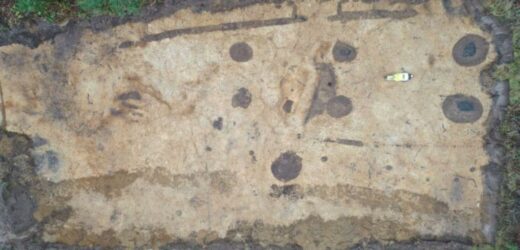Vikings: The Rise and Fall
We use your sign-up to provide content in ways you’ve consented to and to improve our understanding of you. This may include adverts from us and 3rd parties based on our understanding. You can unsubscribe at any time. More info
Archaeologists in Denmark’s North Jutland region have unearthed a “prestigious” Viking hall that they are calling the largest such find in more than a decade. The building — which appears to be up to 131 feet and 26–33 feet wide — was discovered as a result of the dividing up of a detached house plot near the village of Hune. The excavators, as the North Jutland Museums glibly put it, came across a “somewhat older house on the plot”. In fact, the team have said that the hall can immediately be dated back to the time of Harald “Bluetooth” Gormsson, who was the king of Denmark from AD 958 to his death in AD 986 and also of Norway from 970 AD onwards.
Excavation leader and archaeologist Thomas Rune Knudsen of the North Jutland Museums said: “This is the largest Viking Age find of this nature in more than ten years
“We have not seen anything like it before here in North Jutland, even though it has only been partially excavated.”
The Viking site may be even larger than is presently evident, Mr Knudsen added, explaining: “There are probably several houses hidden under the mulch to the east. A hall building of this nature rarely stands alone.”
The hall, he explained, may well have been part of a local nobleman’s farm.


The dig revealed the remains of 10–12 oak posts — each rectangular in cross-section, measuring 20 by 35 inches — which would have once supported the roof of the building.
According to Mr Knudsen, the building was certainly not just a “slightly larger house than average”, but would have likely served an extra function as a gathering place for political meetings and the assembly of large Viking guilds.
The design of the long hall is similar, the team explained, to those found at Harald Bluetooth’s ring castles, such as Fyrkat at Hobro and Aggersborg near Aggersund.
Given this, the archaeologists have tentatively dated the hall back to the late Viking Age — that is, the latter half of the 10th century or the first part of the 11th century.


It may even be possible, the archaeologists have said, to make an informed guess as to which family owned and occupied the hall.
In the nearby Hune church stands a five-foot-tall rune stone dating from around the same time period as the remains — specifically, 970–1020 AD.
On it is inscribed the following text: “Hove, Thorkild, Thorbjørn set their father Runulv den Rådnilde’s stone.”
While the original provenance of the rune stone is not known — beyond that it comes from the local area — the dating makes it very interesting in the context of the hall, Mr Knudsen said.
DON’T MISS:
NASA releases first global picture of Earth from new NOAA-21 satellite [REPORT]
EU losing billions of UK’s cash as Britain ready to fund ‘Bold Plan B’ [INSIGHT]
Kepler telescope shows ‘glitches’ occur in core of red giant stars [ANALYSIS]

Mr Knudsen added: “It is difficult to prove that the found Viking Hall belonged to the family of Runulv den Rådsnilde, but it is certainly a possibility.
“If nothing else, the rune stone and hall represent the same social class and both belong to society’s elite.”
At present, only half of the hall has been excavated — but the dig is expected to resume this year as soon as the weather conditions are suitable.
The archaeologists are also planning to undertake radiocarbon dating of the structure in order to more precisely date its construction, with results expected before the end of the year.
Source: Read Full Article


